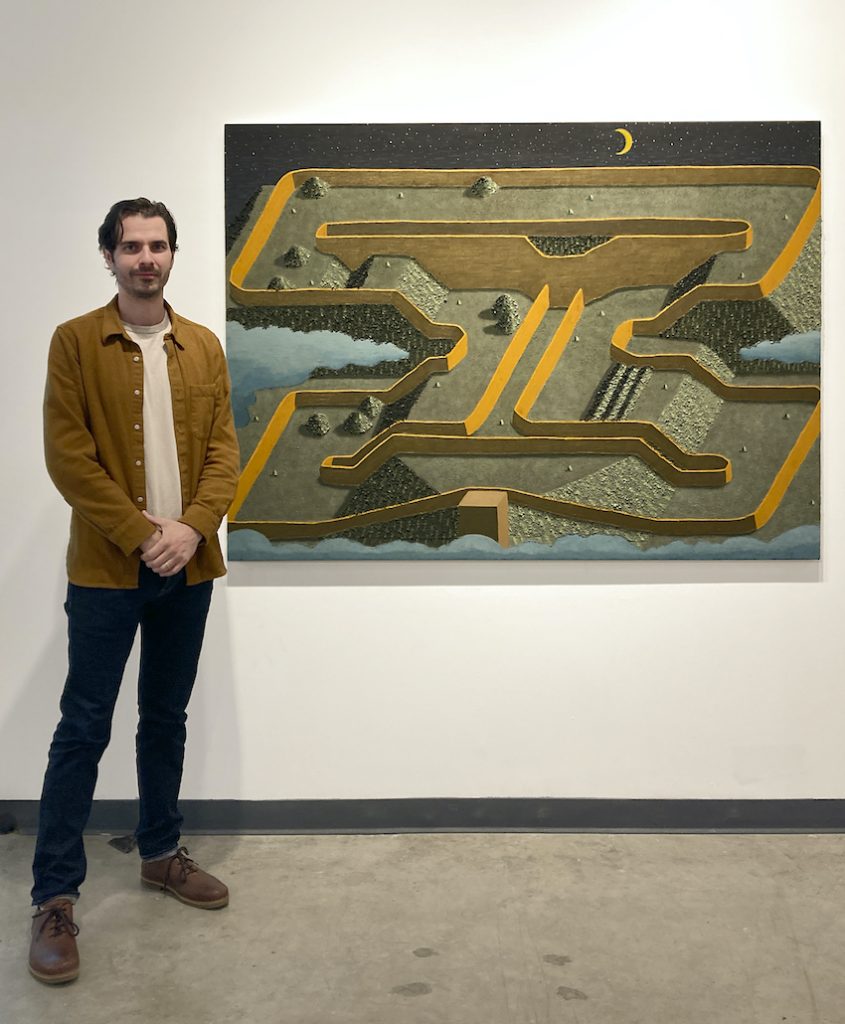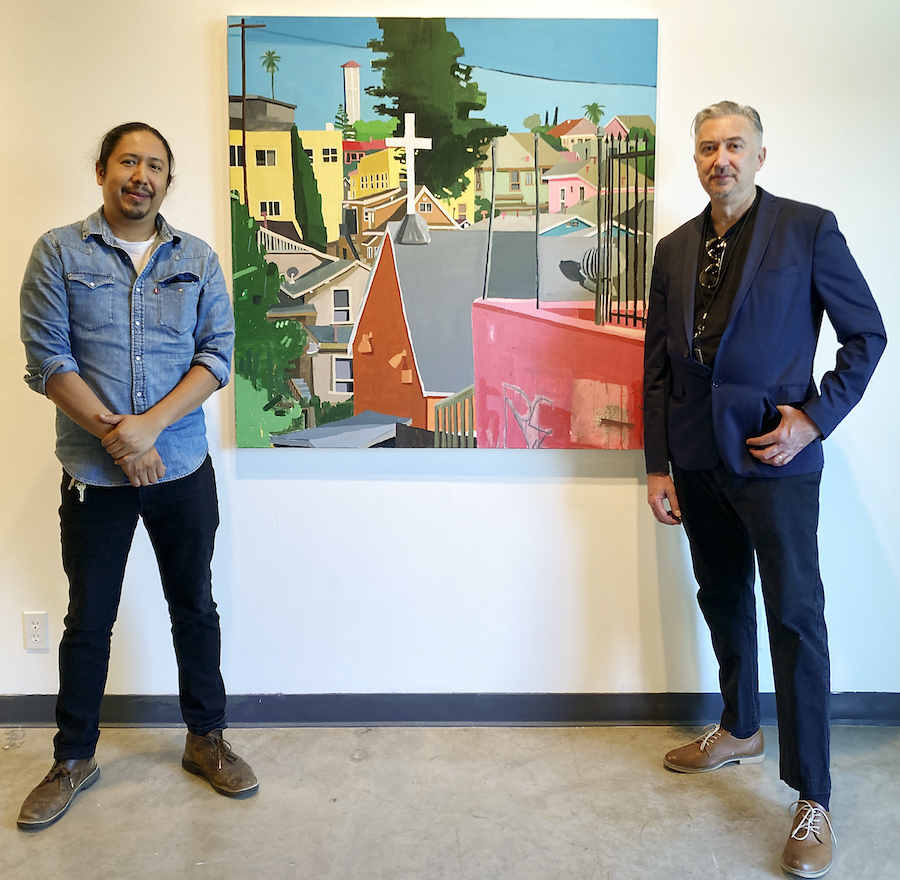New Landscapes Part I: Group Exhibit at the Atkinson Gallery

I attended the opening of an exhibition at the Atkinson Gallery at Santa Barbara City College (SBCC) titled New Landscapes Part I, which is on view through December 8. The artists exhibiting are Whitney Bedford, Diedrick Brackens, Manuel López, Cruz Ortiz, Jonathan Ryan,and Jonas Wood. The exhibition was conceived and curated by Atkinson Gallery Director John Connelly.
Upon entering the gallery, one can view the six works in the open forum space equally. Connelly and I started on the far-left wall and circled around, while I asked for his inspiration to do the show. He shared, “My background is art history, and I like to curate with that reference, and to include it for the students studying art history at SBCC. People are still making landscapes, it is still an enduring topic, so exploring why is that and how did it start. The earliest painting was done in 2000 B.C.” A noted caveat was having seen Ryan’s work four years ago as another influence.
I mentioned to Connelly that after studying the six works, their unifying links include modernism’s take on what is defined as a landscape – compared to the pastoral paintings through Van Gogh one usually finds in museums – as well as varying use of a non-forced flat or floating perspective. Connelly agreed.
Ryan’s piece titled MYST is a 50×68 inch oil and sand on canvas, with mustard yellow guide rails in a maze formation over shaded greens raised with gravel in the paint for the landscape, which appears to float on a blue cloudy sky with a thin horizontal black starlit sky on top. The rails form an abstract maze whose perspectives tilt downward and stop abruptly at a brown wood square peg in the middle. These leading lines can be followed upward and around the piece, viewers take your pick. I talked briefly with Ryan who arrived from Los Angeles with Gerard O’Brien, owner of the Landing Gallery where he exhibits his works:
Q: Any preferred viewing distance? Your choice of textural materials for experience with light and shadow in depth, movement, perspective, and the landscape? It floats in space!
Jonathan Ryan: All viewing approaches work. I move around the studio quite a bit, back and sides, material like gravel and rocks on the paint reflect light and depends on what type of light hits it and changes the experience. I’m grateful for the in-person viewing, as a lot of art today is seen digitally, and I think my work translates fairly well digitally, but it flattens it and makes it very graphical. Where the imagery is coming from is directly pulled from an old video game called Super Off Road that represented a lot of ideas in painting I am interested in, Japanese landscape prints like Hokusai, Hiroshige’s landscapes where the clouds intersect the image, and I’m always interested in late Medieval – Early Renaissance art that is exploring perspective and how it is titled. This piece is synching all that in a way that is really interesting to work with in the studio – from a video game reference to pulling out all my books on painting history. It becomes this interesting visual play.
Next, I talked with López about his work titled I CE(E) all them crosses, but where in the hell is Hey-Zeus?!?!, 48×48” oil and acrylic on canvas.
Q: Can you talk about your composition, use of flat lighting, non-forced perspective, scale, and viewing point of the scene?

Manuel López: I made this piece summer 2018 for my first solo show in Los Angeles for Eastern Projects Gallery, it is a series of three works all the same size and took me about a month to do. I don’t really use perspective in the usual sense. My works all start off from drawings, I am eyeballing it, I don’t measure it so we can relate to the way we see the world. I grew up watching cartoons, reading comic books, and playing the original Nintendo, the graphics are so flat, so my work is a time snap of flatness, like [David] Hockney and [Alexis-Louis] Roche, and all these guys messing with that area. With a canvas, you know it’s a flat surface, so I am not trying to fool the eye. This is an area of Los Angeles, MacArthur Park overlooking the Korean Church, Central American Pentecostal Church and Catholic Church. It is interesting how different cultures are so close to each other and carry their own traditions, but everything is intertwined, for example you can go into a store with a Korean owner who speaks perfect Spanish, but not English.
From there I viewed Brackens’ Stealing Dark from the Sky. Incorporating cotton and acrylic yarn tapestry, with its use of pastels for the landscape area that is broken by two opaque black figures bending over opposite each other and united at the buttock and placed in the center. Ortiz’s Karankawa Red Moon – an oil and sand on canvas – speaks the lovely range of midnight blues to lighter blues in waves horizontally broken down the center by a non-complementary tertiary salmon-colored round moon with its salmon color reflected on the waves. The work homages the Indigenous people of southern Texas. Bedford, with works in collections from Paris to the Hammer, the Saatchi Gallery, London, and at the Santa Barbara Museum of Art, is interested in historical paintings and horizon lines. Her work here titled Veduta (Bonnard Mediterranean Mid-Morning) is a triptych ink and oil on linen (mosaic patterning noted), takes the historical painting of Bonnard with her own cutouts on top of it. It is part of her Veduta series of backgrounding pastoral landscapes and her modernist interpretation of key landscape “parts” like trees on top of it. Best to dive in close for an appreciation of the mosaic detail work and sit back to note the impact of the neon pink willow tree far left spawning into the middle panel and its barely leaved pale pink counterpart on the far right panel. Wood’s four 26”x22” prints titled as a group Four Landscapes, are works that were originally made from 12 to 20 Ukiyo-e Japanese-style woodcuts on Kizuki papers. Each print depicts a family photograph from his childhood, and subtitled individually by season – Fall, Summer, Spring, and Winter.
The Atkinson landscape exhibit is a great way to spend an afternoon with art, entertain your thoughts about what landscape art is to you, and perhaps inspire the viewer to create one.






